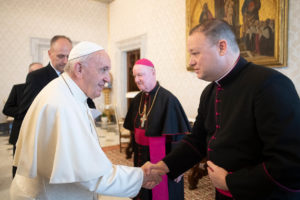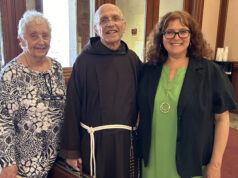(The Dialog news operation is providing special alerts to readers of the Angelus e-newsletter. Sign up here for a free subscription to the Angelus).
Msgr. Steven P. Hurley, vicar general and moderator of the curia, celebrated Sunday Mass that was taped and presented March 28-29 online to Catholics in the Diocese of Wilmington and beyond.
No public Masses are being celebrated as part of the effort to fight the spread of coronavirus.
Below is the homily he delivered at Mass:
——
Unprecedented! Unimaginable! Unbelievable! We’ve never seen anything like this before!
I’m not talking about COVID-19, I’m talking about today’s Gospel.
While these words and phrases are echoing across the world with increasing frequency, similar shouts of astonishment were no doubt uttered by those who were privileged to be witnesses to the raising of Lazarus.
This extraordinary event in salvation history is the crescendo of the last two weeks of our Lenten Gospel readings from John. Recall that two weeks ago, we heard about the woman at the well who was thirsting for the water of life and last week we read about the healing of the blind man. Today, we are given the miraculous account of a dead man being raised. Three readings with three themes; thirst, blindness, and death. Each one a metaphor for spiritual dysfunction with an invitation to consider that healing and wholeness can only be achieved through Christ.

St. Augustine said that “every man is afraid of the death of the flesh; few, of the death of the soul.” What, you may ask, is powerful enough to kill a soul? It’s rather simple…sin. This is what our Gospel reading today is essentially communicating. But, how can this be good news? To truly appreciate its significance, it would be helpful for us to consider the two other Gospel accounts of Jesus raising someone from the dead; the daughter of Jairus from Mark’s Gospel and the Son of the widow of Nain from the Gospel of Luke.
Jairus was a synagogue official whose young daughter had died at home. Jesus restored her life with the words Talitha koum which means “Little girl, I say to you, arise.”
A widow from the city of Nain found herself in a perilous situation as her only son had died. Jesus encounters the funeral process outside of the gate of the city. He stops them, touches the young man’s coffin and says, “Young man, I tell you, arise!” The young man was restored to life.
And we just heard about Lazarus who had been in the tomb for four days. Jesus cried out in a loud voice, “Lazarus, come out!” And Lazarus too was restored to life.
Augustine viewed these three resurrections as representations of different levels of spiritual disorder. He reminds us that these incidents are not just deeds but signs. In other words, each of these events in their own way depict a specific degree of sinfulness and its inevitable effect on our lives. Consider the daughter of Jairus. She was young and innocent and had not ventured out into the world yet, she still suffered from disease, a symptom of our broken world. This is representative of the first stirrings of sin. Perhaps the thought of a sin that has yet to be committed. Just the beginning, not out in the open. We’ve all been there. Negative thoughts and images about people and situations enter our minds and if allowed to gestate, they can create feelings of hostility, resentment, or lust, just to name a few. If left unchecked these inclinations can become sinful in of themselves which can progress from a sin in thought, to a sin in action.
This leads us to the widow’s son. Jesus encounters the funeral procession on their way to the grave. Unlike the little girl, the young man was out of the house yet unlike Lazarus, he was not quite in the tomb. Here we have sins that are committed. Misdeeds that are no longer hidden but out in the open. More serious than just thinking; its doing. Sin that is visible to the world and its effects are felt by others. This I think is where most of us find ourselves. Not innocent because we are constantly dealing with our own propensity to sin, but we are still spiritually alive, fighting the good fight. Falling but getting back up.
Finally, we turn our attention to Lazarus, a grown man who was in the tomb and was truly dead. He’s not at home like Jairus’ daughter and he is not on his way to the tomb like the widow’s son. Lazarus is in the tomb and has been there four days and has started to decay. Augustine describes this as “a grievous kind of death and is distinguished as a habit of wickedness.” Lazarus represents those who have fallen into sin and have no intention of getting up. They knowingly wallow in sin. These are the people of the world who have no moral compass who live their lives in total disregard for others; self-absorbed and spiritually dead.
This all sounds very depressing and certainly not what we need to hear right now. That would be true if stopped we didn’t go any further. The point of all of this is that all three of them who had died, were restored to life. Even Lazarus who would seem to have been beyond help. It was Jesus who raised them, who called them back to life with his voice: Talitha koum. Young man, I tell you, arise. Lazarus, come out.
This is the Gospel, the good news. It is powerful reminder to us that no matter how far we think we have sunk, no matter how awful we think we are, the voice of Jesus calls us back.
Perhaps we have addictions. Perhaps we have done things that we are afraid to even speak about. Maybe we have wondered so far away from God and neighbor that we feel paralyzed. Maybe like Lazarus we feel that we are bound, in the tomb. Sometimes we can entomb ourselves in depression, despair, or fear. Whatever is binding us, no matter what we wallow in, no matter how bad we think it is, there is always hope; there is always redemption. There is always the voice of Jesus calling us to come out of our tombs. His is a voice of healing.
We must not forget this especially in these times of uncertainly and stress. Now, more than ever we need to be mindful of Jesus’ call to discipleship. The brokenness of our world can not and must not overpower us. Now is the time for us to show the world who we are and what we represent. It is a time for us to shine, to reflect the light of Christ into a world that is frightened because for the most part, it is spiritually inept. This is what evangelization is about. Sharing this good news.
We often stumble, sometimes we fall and occasionally we sink. This should not deter us because we know that no one, not even those who are fully dead to the Lord’s presence are outside of his power and authority to be resuscitated and restored. It is Christ who renews us, refreshes us, and puts us back on the road of discipleship.






